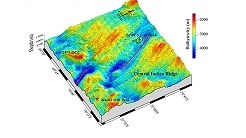- Screen Reader Access
- Skip to : main content / navigation
- Text Size
- Home
- Sitemap
- Contact us
- हिंदी
Hydrothermal vents
Holding secrets of the new and the amazing!
Hydrothermal vents are found in the global mid-oceanic ridge system, which form when plates of the Earth’s lithosphere move apart, giving rise to a new seafloor. As the plates separate, magma rises above the seafloor in the form of a continuous range of underwater volcanic eruptions. The surrounding seawater cools down and solidifies the volcanoes forming mid-ocean ridges. Thus, mid-ocean ridges look like an underwater mountain chain of around 2500 meters height from the seafloor.
The area surrounding mid-ocean ridges often has cracks through which seawater percolates down the crust and gets heated up by magma inside. The heated up water dissolves minerals from the surrounding rocks and comes out as hot springs. After mixing up with the surrounding freezing bottom waters, the dissolved minerals in the hot spring cool down to form hydrothermal vent structures. Fluid temperatures in hydrothermal vents can reach over 371oC. The warm-turbid water rich in trace metals and gases coming out of vents are called hydrothermal plumes.
Hydrothermal vent explorations have been done extensively in the Atlantic and Pacific Oceans. An NCPOR team led by John Kurian Palayil is investigating the less explored Indian Ocean. Recently, Surya Prakash Lankalapalli from the team and collaborators from the USA and Japan set out to find new hydrothermal vent fields in the southern part of the Central Indian Ridge. The Central Indian Ridge, nearly 2000 kilometres in length from 3°N to 25°S, is one of the mid-ocean ridges in the northwest Indian Ocean.
The team surveyed the water column above the ridge region using a conductivity-temperature-depth profiler. They found high turbidity plumes between 2300 and 2700 meter depths and spatially extended between 24°48.62’ S and 24°48.68’ S.

Schematic diagram showing the regions of recent hydrothermal exploration in the Indian Ocean basin by the NCPOR researchers
The researchers collected water samples from the plumes and analysed them for chemical tracers of hydrothermal vents. They found high methane, manganese, and iron concentrations and unique isotopic ratios of helium and methane, which were characteristic of hydrothermal vents. The geochemical composition also showed that the plumes are formed from the fluids circulated through ultramafic rocks commonly found in the mantle.
The team examined the structural and mineralogical properties of the plume particles. They identified hydrothermal sulfides- pyrite and chalcopyrite, and sulfates- barite, which indicated the emission of high-temperature fluids. Thus, the researchers claim the existence of a new hydrothermal vent field on the southern Central Indian Ridge near 24°49’ S.
Another team from the same group, led by Deepak Kumar Agarwal, recovered wustite-magnetite mineral spherules from the sediment samples collected from the southern Central Indian Ridge region. Spherule comes from the Greek word “sphaira” for sphere. This word is often associated with meteorites and cosmic matter. Such spherules are rare on Earth. But the researchers claimed that those recovered by them were of non-cosmic origin.
Wustite is a mineral form of iron (II) oxide, and its presence indicates a reducing environment where a lack of oxygen prevents oxidation. Magnetite is an oxide of iron (II) and iron (III) with very strong magnetic properties.
The researchers investigated the physical and chemical properties of the spherules. They processed the collected sediments by washing and sieving and isolated magnetic particles of size greater than 250 micrometres. Using a microscope, the team picked iron-rich spherical grains. Nineteen spherules were recovered from 85 grams of one of the samples. The researchers found that the spherules were spherical, ellipsoid, black, and highly reflective when imaged using a Scanning Electron Microscope. The particles looked polished with few depressions on the outside.
The team analysed the elemental composition of the particles using an Electron-probe microanalyser. Cosmic wustite-magnetite spherules often contain nickel and a minor amount of manganese. However, the researchers observed a relatively higher amount of manganese with no nickel in their spherules. This made them speculate that the recovered spherules were not cosmic. However, there may be a possibility that the spherules were cosmic but lost nickel during flight through the atmosphere.
In such a case, the researchers explained that manganese, which has a lower boiling point than nickel should have evaporated first. So, the presence of manganese but an absence of nickel indicates a non-cosmic origin. In addition, the team found that the composition of ferrihydrites was also different from that of meteorites. And many other phases which regularly occur in meteorites, like chromite and metal bead, were also absent in the spherules recovered from the hydrothermal field.
How do such magnetic spherules form in the deep sea? Wustite forms under reducing conditions when iron (III) reduces to iron (II), which is why it is commonly found in meteorites of extraterrestrial origin where oxygen is less. In the ocean, the researchers suggest that wustite-magnetite spherules may form under very high temperatures and reducing conditions of the hydrothermal field. Another way of formation is the alteration of cosmic spherules containing less manganese by manganese-rich hydrothermal fluids. Finally, they linked the recovery of non-cosmic wustite-magnetic spherules in the southern Central Indian Ridge region to reinforce hydrothermal activity nearby.
The extreme environment of hydrothermal vents house unique and endemic species. A team studying benthic or bottom-dwelling animals led by Periasamy Ranjaiyan discovered some new species from the Indian Ocean ridge region. They collected deep sea organisms using benthic sledge on the sea bottom.
From the Southwest Indian Ridge region, the team reported a sponge-associated shrimp Spongicoloides weijiaensis, which was not reported from this region earlier. Although the species is known to live in the deep oceans, the maximum reported depth was 2279 meters in the Northwest Pacific Ocean. However, the NCPOR team recovered the species from a deeper depth of 2358 meters.
Morphological and DNA analysis revealed that Spongicoloides weijiaensis of South West Indian Ocean Ridge is similar to the species of the Northwest Pacific Ocean. However, the researchers noted slight variations like pigmented eye and additional large carapace spine in their reported species, thus pointing it to be a variant of the Northwest Pacific species.
The team discovered three new carnivorous sponges in yet another cruise in the Central Indian Ridge region. Sponges are stationary, multicellular benthic organisms with no organs. Skeletal differences, especially in the spicules - microscopic crystal structures, are often used to differentiate between the species.
The researchers found the collected species were similar to the carnivore sponges Asbestopluma pseudoisochela and Abestopluma jamescooki from South West Indian Ocean Ridge and Chondrocladia clavata from the Southern Ocean. However, significant differences in the morphology of small and large spicules made them do DNA analysis that confirmed the novelty of the species. The researchers have deposited specimens of the new species in the collection of the Hydrothermal Biological Department, NCPOR and have obtained accession numbers for them. They named the new species Abestopluma indiyansis, sp. nov. (Accession No: NCPOR/HYD-CIR/0031), Asbestopluma (A.) bharatiyae sp. nov. (Accession No: NCPOR/HYD-IOCIR/0034) and Chondrocladia sagari sp. nov.( Accession No: NCPOR/HYD-CIR/0035).
The same team also discovered another new deep sea sponge species from an Oceanic Core Complex at 25°S near the Indian Ocean Triple Junction in the Central Indian Ocean Ridge. At this junction, the African, Indo-Australian, and Antarctic plates meet. Oceanic Core Complexes are often associated with slow-spreading mid-ocean ridges, where magma doesn’t get enough space to come out. And resultant pressure gives rise to dome-shaped Core Complexes perpendicular to the ridges.
The researchers carried out morphological and DNA analysis of the collected sponge and found that it belonged to the genus Fibulia. They compared the collected sponge with ten known species of Fibulia and found differences in the morphology, especially in the spicules. The collected sponge also had a unique shape of spicules with plate-like structures at its end called isochelaes with a strongly curved shaft and well-formed frontal alae. With these key morphological differences supported by DNA analysis, the researchers named the new species Fibulia occiensis sp. nov. (Accession No: NCPOR/HYD-CIR/0029)
The biodiversity of the Oceanic Core Complex in the Central Indian Ocean Ridge region is almost unknown until now and thus presents a potential site for future deep-sea mining. The extreme temperature and pressure of hydrothermal vents give rise to interesting minerals, composites, and even life that thrives here. Bacteria do chemosynthesis in the deep dark vent regions to make food from the available chemicals and kick start unique biodiversity. With the ongoing explorations, we have just started an amazing journey in the unknowns of the hydrothermal vents in the Indian Ocean.
Science Update Team


For feedbacks or to join the team, contact ncporoutreach@gmail.com